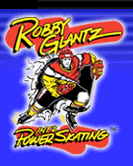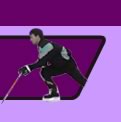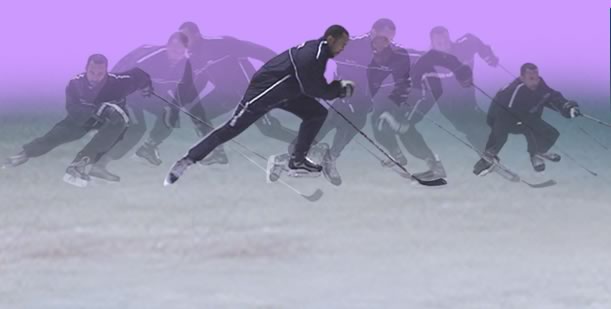°
angle (halfway to the ice). As you improve
and get more confidence, you will be able to
push the angle of the edge to even more
extremes.
Make
sure you apply as much downward pressure as
possible into the middle of the blade,
getting as much of it as you can in contact
with the ice. Too much pressure to the
front/middle of your blade (toward the toe),
will make you come off the edge and lose
your balance forward. And likewise, too
much weight to the back of the edge (toward
the heel), will rock you backward and take
away from the forward momentum you will need
to build speed.
FORWARD STRIDE EDGING
In the Forward Stride, you
should try to start each push on one foot,
firmly planted on an inside edge, rolled
halfway to the ice. And the ability to
maintain that grip while pushing through the
ice for a long enough period of time is one
of the vital elements in the quest for more
speed.
At
the same time, you will want to use 100%
bodyweight on every push you make. The more
bodyweight you get centered over the edge,
the more power and thrust you will get on
each stride.
In
order to get 100% bodyweight centered on the
inside edge, it is necessary that you
recover the other foot so it is fully under
your body, that gives you the ability to
shift your weight properly to the pushing
foot (See Zubov Photo on the right).
FORWARD STRIDE INSIDE EDGE DRILL
Drill: Inside Edge to Inside Edge
Techniques:
·
The
drill goes from one goal line to the other.
·
Start
with a couple of forward strides to build
speed.
·
Then,
while facing the boards to your right, ride
your right inside edge around forming a half
circle until you are ultimately facing the
boards to your left.
·
Your
left foot should be tucked in behind your
right skate heel to maximize the grip of the
inside edge (center your weight directly
over the edge).
·
Once
you are facing the side boards on your left,
snap the right leg to full extension (this
will build up speed and momentum), switching
to the left inside edge.
·
Now,
ride the left inside edge for a half circle,
until you are facing the side boards on your
right again and then push the left leg to
full extension, again building momentum to
switch to the right edge.
·
Keep
changing edges and building speed (while not
shortening the time you are on the edge on
one foot) until you get to the far goal
line.
·
Variation:
Do the drill to the redline and at the
redline skate full speed to the far goal
line… making every attempt to apply the edge
drill into your stride.
Body
Positioning in the Drill:
·
With
the eyes forward, lean the upper body
forward with the back of your helmet in
front of your glide knee (don’t hunch over
or look down however).
·
Bend
the knees deeply to get the most out of your
muscles in your legs.
·
Roll
the skate, at the ankle, halfway to the ice
(45°)
for
proper grip.
·
Apply
downward pressure into the middle of the
blade (not the toe or heel), so the edge
will hold throughout the turn.
·
Keep
the other skate off the ice, tucked in
behind the skate that is rolling on the edge
(maintaining a narrow base)… this will allow
you to hold 100% bodyweight throughout the
turn.
·
Be
sure not to bounce up and down (we call it
yo-yo skating)… stay at one level throughout
the exercise.





